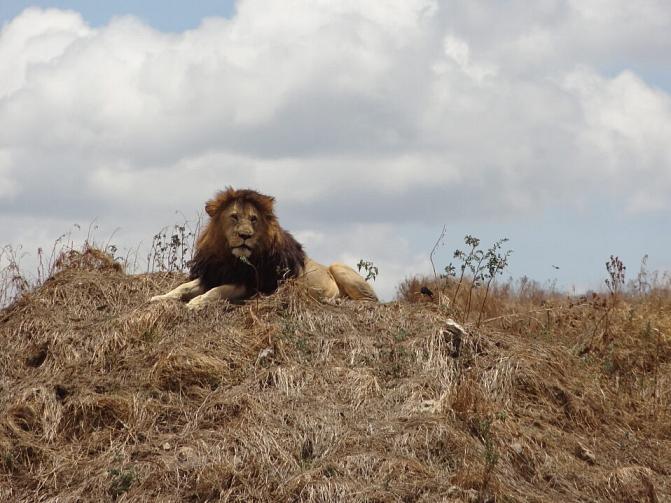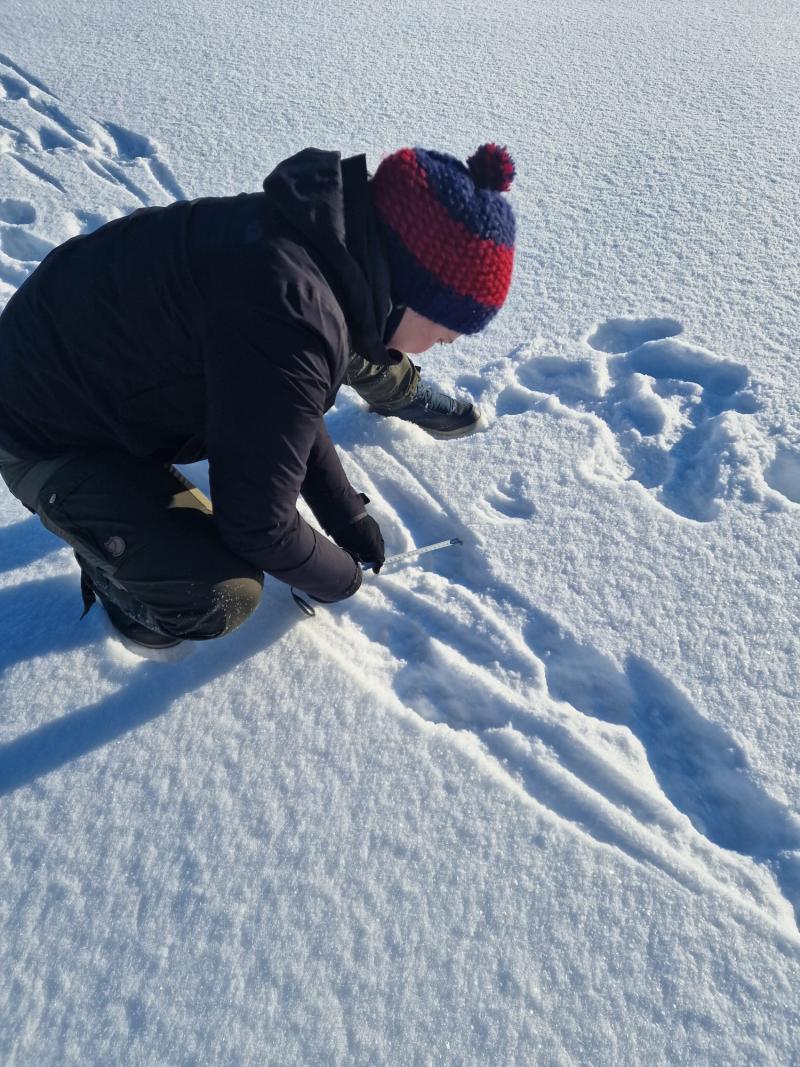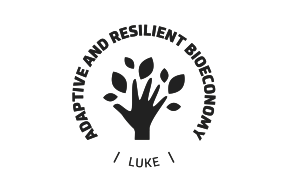Living together with lions in Tanzania and wolves in Finland is experienced surprisingly alike, yet managed so differently
What is it like to share your environment with lions? How does that differ from sharing it with wolves? And what can the one situation learn from the other when it comes to coexistence between humans and apex predators? Master’s student Loes Huibers is trying to figure this out. She was all about lions until she travelled from Tanzania to Finland to study humans and wolves over the winter.

18. That is the number of inhabitants that Finland has per squared kilometre (estimate from 2024). The same number for the Netherlands – where I come from – is 524 (estimate from 2024). Imagine how overwhelmingly vast the country feels. Even more so, the place where I literally came from before setting foot in Finland, is Dar es Salaam. This is the biggest city in Tanzania and has more inhabitants than the whole of Finland combined.
All these facts and figures to set the stage… My name is Loes Huibers, I am a Master’s student at Wageningen University & Research and doing the track Policy & Society within the Master’s Forest and Nature Conservation. Out of big curiosity and interest, I travelled to Finland to join teams and initiatives within the LIFE BOREALWOLF (SusiLIFE) project. I did so across Finland in seven different areas and their surroundings: Evijärvi, Helsinki, Oulu, Suomussalmi, Joensuu, Pori and Seinäjoki. The activities at these places added up to my Master’s internship, which encompassed a very interesting and exciting period from December 2023 to March 2024.
From Tanzania to Finland – a similar image of apex predators on opposite sides of the globe
Going to Tanzania had the same reason as coming to Finland. What has been sparked inside me, is a passion for green debates and a drive to learn how to navigate within the forcefield around them! People in Finland and Tanzania are both faced with ecological, (e-)social and economic challenges related to living with apex predators.
One could say that coexistence with the lion in Northern Tanzania (more specifically in the Tarangire-Manyara Ecosystem – a wildlife corridor) is fairly similar to coexistence with the wolf throughout Finland. Both apex predators in question have this dual, contradictory image. On the one hand, they are to be revered and highly respected. On the other hand, there is talk of fear of and disturbance by the animals.
As holds for the wolf in Finland, the most conflicts with lions in Tanzania are depredation events. I have been going around with questionnaires in 12 local communities to ask those “street-level environmentalists” how they feel about meeting lions in their village. To put the findings into perspective, I have interviewed 4 people from protected area management, interacted with 4 non-governmental organisations (NGOs) and experienced along with 8 wildlife rangers (including anti-poaching units). The mentioned parties have one prevailing observation in common: coexistence with lions is experienced as an inevitable given.
(The text continues after the photo.)
From enemy to respected stakeholder – a villager in Tanzania feels to be less valued than a lion
Nowadays in the Northern part of Tanzania, there is talk of more permanent settlements as opposed to a nomadic lifestyle. A switch is taking place from hunting and gathering to agricultural activities. Also, the human population is growing and lions are growing in numbers too, making it impossible to not have humans and wildlife sharing land. However, the action perspective among the said street-level environmentalists to handle the consequences of living together with lions is limited.
There is openness to explore more adequate and more diverse options for a harmonious coexistence between humans living in villages peripheral to protected areas and lions roaming around. Exploring certain options for coexistence is something that is given high priority to, because at this point, there is dissatisfaction with the effectiveness of human-lion management. The current dissatisfaction can in part be ascribed to the impression that people feel themselves to be less valued by the government – and the interventions it proposes to target the issue of coexistence – than lions.
Villagers mention that they feel to be portrayed as the “enemy” of the natural living environment that represents their home. Emotions are visibly running high when a conversation flows towards the topic of retaliation killings. Many respondents made comments of discontent about the fact that a villager would be put into prison when it would kill a lion, whereas a depredation event is followed by consolation.
From consolation to compensation – a substantially different approach in Tanzania and Finland
Consolation – which is currently the legal procedure after livestock predation by lions – is said to be not enough to make up for the loss in income by a depredation event. Villagers highlight that compensation measures should be taken. That is one of the significant differences with the human-wolf situation in Finland, where compensation is a fact. Another main difference is that Finland has (governmental) structures in place that are equipped to manage the human-wolf situation in the country, while this is not the case in Tanzania.
Most initiatives there are non-governmental. They focus on offering knowledge (information sessions on what to do, who to contact and where to go for help), tools (fortified fences, guarding dogs and scare-away tools to prevent livestock losses) and a safety net (wildlife patrols, contacts for help and on-location guidance after conflicts). Examples of actions by government bodies to keep the attitude of villagers positive include rewarding the commitment to agreements (for example celebrating after a successful harvest) and offering assistance with funerals (mostly with the aim of showing sympathy for the suffered loss).
As these examples show: only investing in conflict management on the short term rather than on conflict resolution on the long term is felt to be not sufficient. What villagers and NGOs point out to be missing in the current conservation agenda in the Tarangire-Manyara Ecosystem is democratic engagement of the local communities. That democratic engagement can be fruitful, is what SusiLIFE is showing with regard to the wolf. I have had the opportunity to experience this first hand!
From vacuum to volunteer networks – a structure for democratic engagement can be of unique help
‘Fieldwork on large carnivore monitoring’ was the theme of my first internship week with SusiLIFE. This meant following snow tracks of large carnivores – mainly wolves – and taking DNA-samples along the way. Also the pack size, sex and age of the wolves were assessed. Upon doing so, there was help and campfire-brewed coffee from trained volunteers (going by the name of ‘Large Carnivore Observers’. I have therewith seen the “glove” of the project in motion, reaching within and most importantly uniting actors in the artilleries of the wolf management.
The fieldwork included driving, walking and skiing through the winter wonderlands of remote forest areas in the West of Finland. And not to forget: many triggering, satisfyingly pragmatic conversations about – among other topics – the do’s and don’ts within the current wolf management, the decision making processes around it and the stakeholders involved. Exciting and informative, I would say! The internship started off “with your feet in the clay” – as a Dutch expression goes. Freely translated, the Finnish version would be “with your feet in the snow” 😉
I have enjoyed a lot and learned a lot! My touch with SusiLIFE, its people and the Finnish nature in general has been intriguing. On to more deepening, broadening and eye-opening experiences.
The project offered me the opportunity to dive into the topic of human-wildlife coexistence as well as the human-human dimensions of this in more detail. Kiitos!
Happy greetings,
Loes
Photos © Loes Huibers




